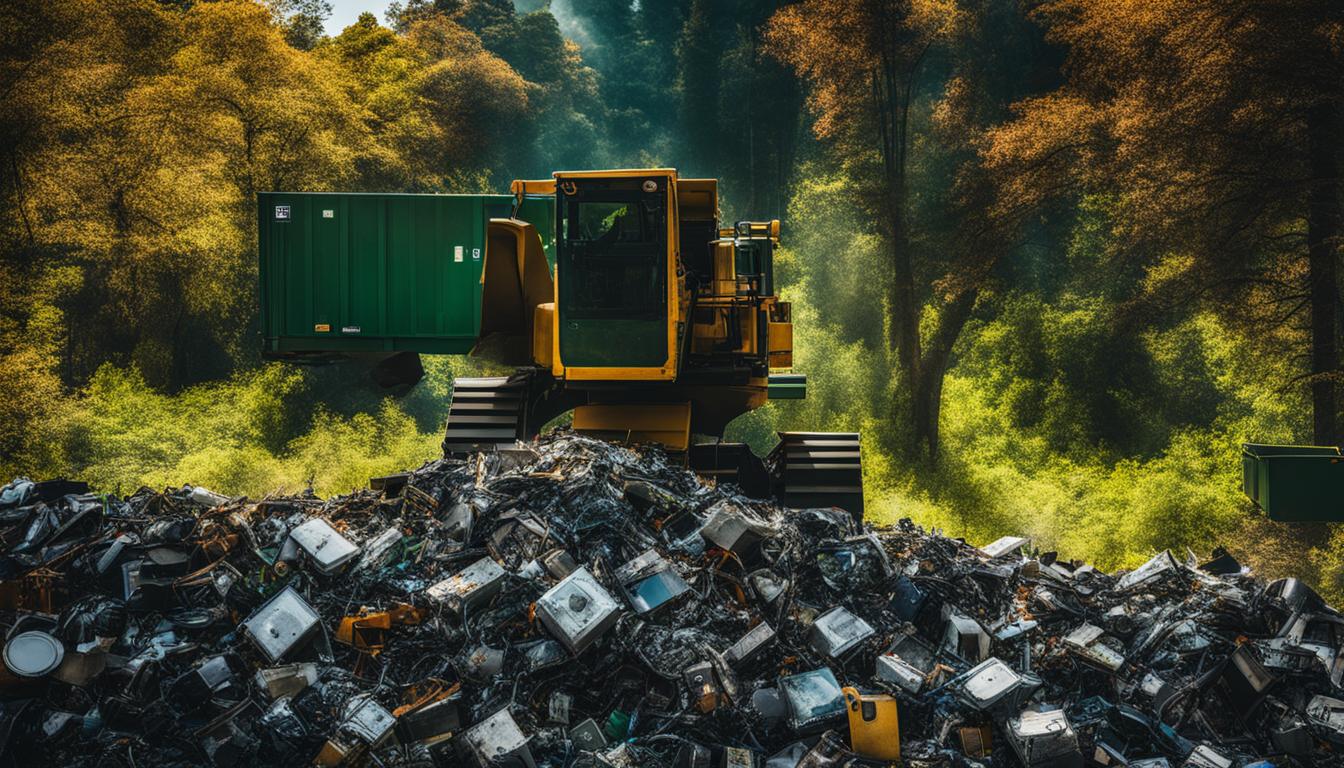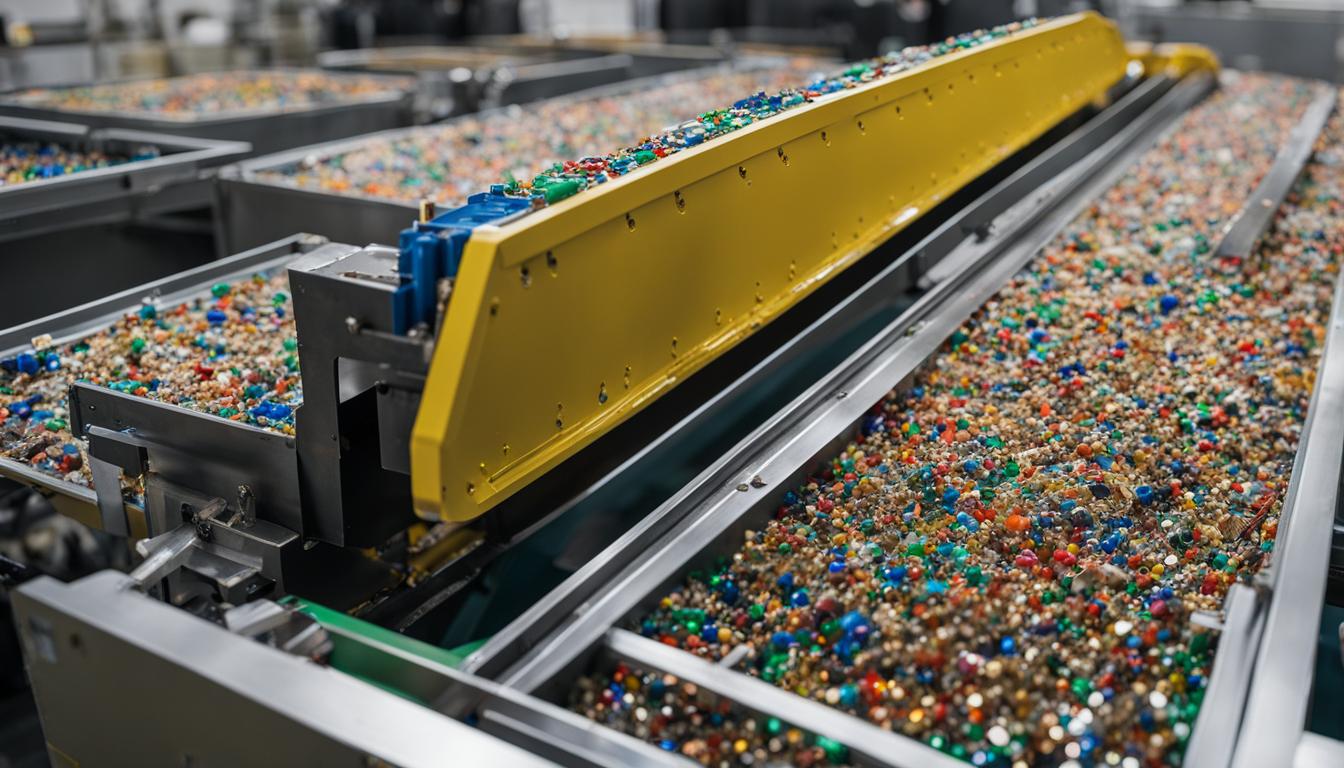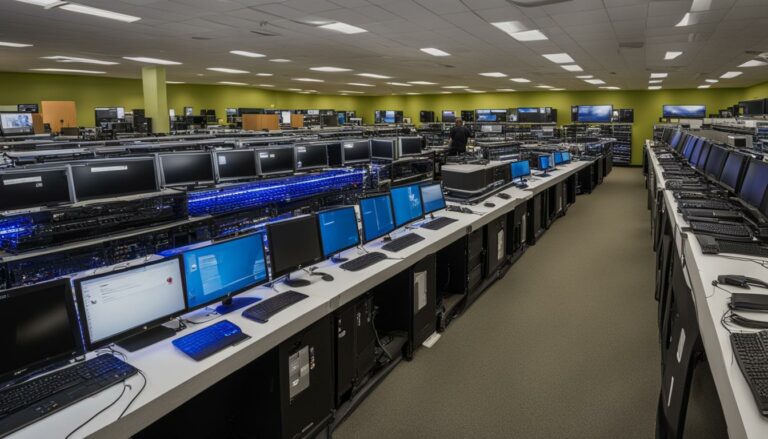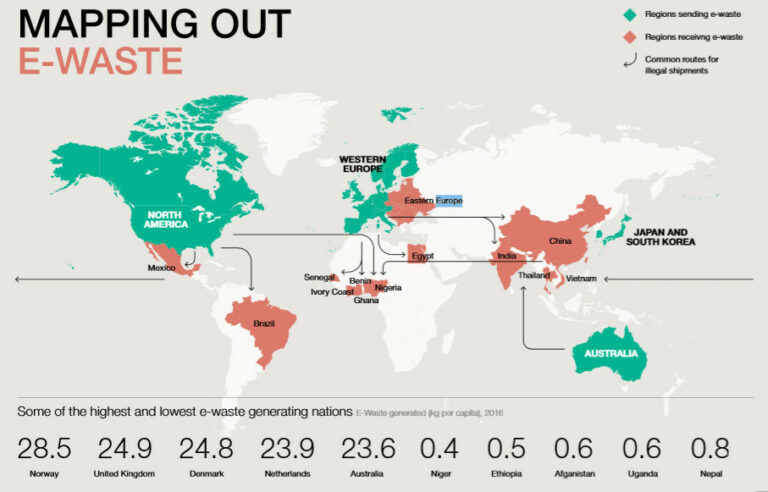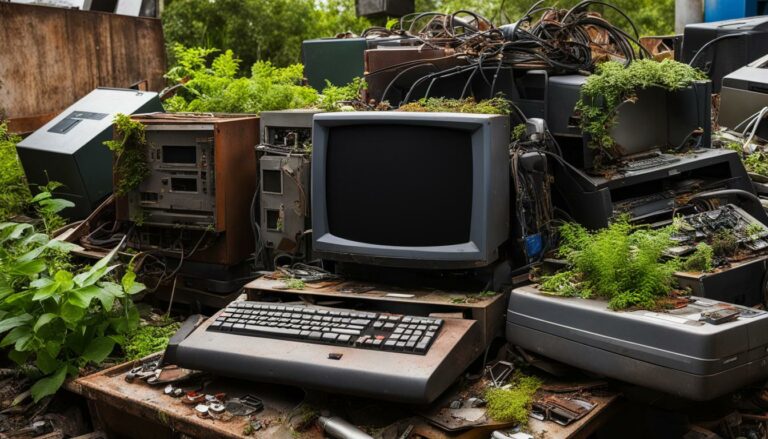Case Study: Successful IT Recycling Programmes in Corporations
Dell, one of the world’s largest computer manufacturers and technology companies, has implemented a successful IT recycling programme. The programme focuses on responsible e-waste disposal and aims to create a more efficient and sustainable product ecosystem. Dell has taken a full lifecycle approach, emphasising product design for repairability and recyclability. They also incorporate sustainable materials, such as recycled plastic, into their products and packaging. The Dell Recycling programme has recovered 1.76 billion pounds of electronics since 2007 and has a closed-loop plastic supply chain that has created nearly 5,000 tonnes of new parts for various products.
Key Takeaways:
- Corporate IT Recycling Programmes play a crucial role in promoting environmental sustainability.
- Responsible e-waste disposal is important for preserving the environment and presents a business opportunity.
- Dell’s approach to IT recycling focuses on the entire product lifecycle, emphasizing design for repairability and recyclability.
- Dell’s IT recycling programme has achieved significant success, recovering billions of pounds of electronics.
- The Australian National Television and Computer Recycling Scheme is a comprehensive e-waste management programme.
The Importance of Responsible E-Waste Disposal
E-waste management and responsible technology disposal have become increasingly crucial in today’s world. With the rapid advancement of technology and short product lifespans, the amount of electronic waste, or e-waste, is skyrocketing. Globally, the recycling rate for e-waste is only 15%, highlighting the urgency to address this issue.
Responsible e-waste disposal not only helps preserve the environment but also presents significant business opportunities. By implementing sustainable practices and incorporating recycled materials into products, companies can create a more efficient and sustainable product ecosystem. This reduces the reliance on finite resources and contributes to the overall well-being of the planet.
Additionally, responsible disposal of e-waste reduces the amount of hazardous materials in landfills, minimizing the risk of pollution and promoting resource conservation. It also aligns with sustainability initiatives and demonstrates a company’s commitment to environmental stewardship. Furthermore, proper e-waste management can open up economic benefits by reducing the carbon footprint associated with manufacturing and creating a circular economy that maximizes resource efficiency.
The Environmental Impacts of E-Waste
It is essential to recognize the environmental impacts of e-waste. Many electronic devices contain hazardous materials such as lead, mercury, and cadmium, which can contaminate soil and water sources if not properly disposed of. In addition, the manufacturing and disposal of electronic devices contribute to greenhouse gas emissions, further exacerbating climate change.
“Proper e-waste management is an integral part of sustainable business practices. By responsibly disposing of electronic waste and implementing recycling initiatives, companies can make a significant positive impact on the environment.” – Industry Expert
To address these challenges, it is crucial for companies to adopt responsible e-waste disposal practices. This involves partnering with certified recyclers who follow strict environmental standards and ensuring that e-waste is handled and processed ethically. By doing so, companies can contribute to a more sustainable future while also reaping the benefits of reduced environmental risks and improved corporate social responsibility.
| Benefits of Responsible E-Waste Disposal | Sustainability Initiatives | Financial Savings |
|---|---|---|
| Reduced environmental impact | Contribution to circular economy | Lower manufacturing costs through material reuse |
| Enhanced brand reputation | Alignment with corporate sustainability goals | Reduced disposal and landfill costs |
| Improved resource conservation | Positive public perception | Economic benefits from recycling and reusing materials |
Dell’s Approach to IT Recycling
Dell takes a comprehensive approach to IT recycling, focusing on the entire product lifecycle to ensure responsible and sustainable disposal of electronic waste. Their commitment to corporate recycling services includes prioritizing product design for ease of repair and recyclability, as well as incorporating sustainable materials into their products and packaging. Dell also places a strong emphasis on secure data destruction, protecting sensitive information from falling into the wrong hands.
One of Dell’s key initiatives is their Global Takeback program, which allows customers to conveniently dispose of old electronics by offering free recycling services. This program not only ensures that products are disposed of responsibly and securely, but also promotes resource conservation by encouraging the recovery of valuable materials. Dell’s holistic approach to IT recycling encompasses every stage of the process, from design to disposal, ensuring that sustainability is at the core of their operations.
To further highlight Dell’s commitment to secure data destruction, they collaborate with certified partners who specialize in electronic waste management. These partners employ industry-leading practices to ensure that data is effectively erased and destroyed, giving customers peace of mind that their sensitive information will not be compromised. By prioritizing secure data destruction, Dell sets the standard for responsible IT recycling and reinforces their dedication to protecting customer privacy.
Key Features of Dell’s IT Recycling Approach:
- Product design for ease of repair and recyclability
- Incorporation of sustainable materials into products and packaging
- Global Takeback program for convenient and free recycling services
- Secure data destruction to protect sensitive information
- Collaboration with certified partners specializing in electronic waste management
| Benefit | Description |
|---|---|
| Responsible Disposal | Dell’s IT recycling approach ensures that electronic waste is disposed of responsibly, reducing the environmental impact and promoting sustainability. |
| Resource Conservation | By recovering valuable materials through recycling, Dell contributes to resource conservation and reduces the need for virgin resources. |
| Data Security | With a focus on secure data destruction, Dell protects sensitive information from being accessed or misused. |
| Sustainable Product Ecosystem | By incorporating sustainable materials and designing for repairability and recyclability, Dell contributes to a more efficient and sustainable product ecosystem. |
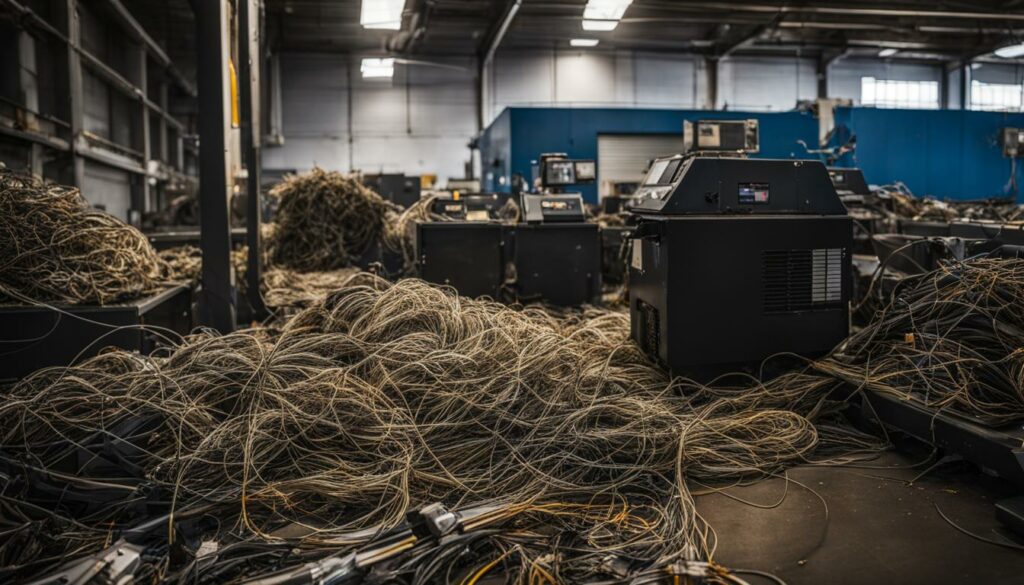
Performance and Benefits of Dell’s IT Recycling Program
Dell’s IT recycling program has been highly successful, delivering impressive performance and contributing to both financial and environmental savings. Since 2007, the program has recovered a staggering 1.76 billion pounds of electronics. This achievement is a testament to Dell’s commitment to responsible e-waste disposal and sustainable practices.
One of the key highlights of Dell’s program is its closed-loop recycled plastic supply chain. Through this innovative approach, Dell has been able to create nearly 5,000 tonnes of new parts for over 90 products. By recycling and reusing materials, Dell minimizes the need for virgin resources and reduces the carbon footprint associated with manufacturing. This not only benefits the environment but also provides significant financial savings for the company.
Dell’s closed-loop model is not only environmentally friendly but also economically advantageous. By repurposing materials and reducing reliance on virgin resources, Dell has achieved substantial cost savings while contributing to a more sustainable future.
The financial and environmental savings of Dell’s IT recycling program have been quantified through collaboration with TruCost. This analysis provides a comprehensive assessment of the program’s impact, highlighting the key benefits of recycling and responsible disposal. By diverting e-waste from landfills and adopting a circular economy approach, Dell has not only reduced its environmental footprint but also improved resource efficiency and long-term sustainability.
| Performance | Benefits |
|---|---|
| Recovered 1.76 billion pounds of electronics | Reduced carbon footprint |
| Created nearly 5,000 tonnes of new parts | Minimized reliance on virgin resources |
| Significant cost savings |
The performance and benefits of Dell’s IT recycling program demonstrate the positive impact that corporate sustainability initiatives can have. By prioritizing responsible e-waste disposal and implementing circular economy practices, Dell has set an example for other corporations to follow. Through these efforts, companies can contribute to a more sustainable future while also reaping the financial rewards of resource efficiency and environmental stewardship.
The Australian National Television and Computer Recycling Scheme
The Australian National Television and Computer Recycling Scheme is a successful example of a comprehensive e-waste management program. Under this scheme, the television and computer industries are obligated to fund the collection and recycling of a portion of waste products. The main objective of the scheme is to divert potentially hazardous e-waste from landfills, increase the recovery of usable materials, and improve recycling accessibility for communities across Australia.
One of the key aspects of the scheme is the provision of free recycling services to households and small businesses. This ensures that individuals have easy and convenient access to responsible e-waste disposal. By offering free services, the scheme encourages greater participation and reduces the likelihood of e-waste being improperly disposed of.
The Australian National Television and Computer Recycling Scheme is regulated by the Product Stewardship Act 2011. This legislation promotes responsible resource management and aims to reduce the environmental impact of end-of-life products. By holding the television and computer industries accountable for their waste, the scheme encourages a more sustainable approach to e-waste management and recycling.
Benefits of the Australian National Television and Computer Recycling Scheme
The scheme has several benefits for both the environment and the community. By diverting e-waste from landfills, it helps to minimize the release of hazardous substances into the environment and reduces the risk of pollution. Additionally, the scheme promotes the recovery of valuable materials from discarded electronic devices, which can be reused in the manufacturing of new products.
Furthermore, the accessibility of free recycling services ensures that all individuals, regardless of their financial resources, can dispose of e-waste responsibly. This helps to create a more inclusive approach to e-waste management and helps to prevent illegal dumping or ineffective disposal methods.
The Australian National Television and Computer Recycling Scheme demonstrates the importance of product stewardship and the role it plays in promoting a circular economy. By holding industries responsible for their products throughout their entire lifecycle, the scheme encourages sustainable practices and contributes to the conservation of resources.
Conclusion
Corporate IT recycling programs, such as those implemented by Dell and the Australian National Television and Computer Recycling Scheme, have a vital role to play in promoting environmental sustainability. These programs not only divert e-waste from landfills but also contribute to a more efficient and sustainable product ecosystem.
By incorporating recycled materials, designing for repairability and recyclability, and implementing responsible disposal practices, corporations can make a positive impact on the environment. They can help reduce the overall amount of electronic waste in circulation, minimize the carbon footprint associated with manufacturing, and conserve valuable resources.
Implementing IT recycling initiatives not only benefits the planet but also contributes to financial savings and the overall well-being of society. It opens up economic opportunities by reducing dependence on fossil fuels and creating a circular economy. Furthermore, by ensuring responsible electronic waste disposal, corporations can help protect the environment for future generations.
FAQ
How does Dell’s IT recycling program work?
Dell’s IT recycling program focuses on responsible e-waste disposal and incorporates a full lifecycle approach. They design their products for repairability and recyclability, use sustainable materials, and operate a Global Takeback program for convenient disposal.
What is the goal of Dell’s IT recycling program?
The goal of Dell’s IT recycling program is to create a more efficient and sustainable product ecosystem by promoting responsible e-waste disposal and incorporating recycled materials into their products and packaging.
How much e-waste has Dell’s recycling program recovered?
Since 2007, Dell’s recycling program has recovered 1.76 billion pounds of electronics, diverting them from landfills and promoting resource conservation.
What is the Australian National Television and Computer Recycling Scheme?
The Australian National Television and Computer Recycling Scheme is a program that requires the television and computer industries to fund the collection and recycling of a portion of waste products. It aims to divert e-waste from landfills, recover usable materials, and improve recycling accessibility for communities across Australia.
Is there a cost for recycling services under the Australian National Television and Computer Recycling Scheme?
No, recycling services provided under the scheme are free of charge for households and small businesses.
How do corporate IT recycling programs promote environmental sustainability?
Corporate IT recycling programs, like Dell’s, divert e-waste from landfills, incorporate recycled materials, and design for repairability and recyclability. These initiatives contribute to a more efficient and sustainable product ecosystem and help reduce the environmental impact of end-of-life products.

